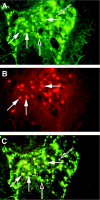Localization of cyclooxygenase-2 in human sporadic colorectal adenomas
- PMID: 10666384
- PMCID: PMC1850032
- DOI: 10.1016/S0002-9440(10)64759-1
Localization of cyclooxygenase-2 in human sporadic colorectal adenomas
Abstract
A putative target for the anti-colorectal cancer action of nonsteroidal anti-inflammatory drugs is the inducible isoform of cyclooxygenase (COX), COX-2. COX-2 is expressed within intestinal adenomas in murine polyposis models, but expression has been poorly characterized in human colorectal neoplasms. Therefore, we investigated the localization of the COX-2 protein in human sporadic colorectal adenomas. Immunohistochemistry for COX-2 and CD68 (a tissue macrophage marker) was performed on formalin-fixed, paraffin-embedded (n = 52) and frozen, acetone-fixed (n = 6) sections of human sporadic colorectal adenomas. Forty of 52 (77%) formalin-fixed adenomas expressed immunoreactive COX-2. COX-2 was localized to superficial interstitial macrophages in 39 cases (75%) and to deep interstitial macrophages in 9 cases (17%). COX-2 staining of dysplastic epithelial cells was observed in 15 cases (29%). A logistic regression analysis identified the adenoma site (P = 0.012) and histological type (P = 0.001) as independent predictors of superficial macrophage COX-2 expression. There was no relationship between the number of macrophages within an adenoma and macrophage COX-2 expression. These results indicate that COX-2 is expressed predominantly by interstitial macrophages within human sporadic colorectal adenomas. If COX-2 does indeed play a role in the early stages of colorectal carcinogenesis in man, these data suggest COX-2-mediated paracrine signaling between the macrophages and epithelial cells within adenomas.
Figures



Similar articles
-
Interstitial cell cyclooxygenase-2 expression is associated with increased angiogenesis in human sporadic colorectal adenomas.J Pathol. 2002 Dec;198(4):435-41. doi: 10.1002/path.1223. J Pathol. 2002. PMID: 12434412
-
Human colorectal adenomas demonstrate a size-dependent increase in epithelial cyclooxygenase-2 expression.J Pathol. 2002 Dec;198(4):428-34. doi: 10.1002/path.1232. J Pathol. 2002. PMID: 12434411
-
Subepithelial myofibroblasts express cyclooxygenase-2 in colorectal tubular adenomas.Clin Cancer Res. 2004 Sep 1;10(17):5870-9. doi: 10.1158/1078-0432.CCR-0431-03. Clin Cancer Res. 2004. PMID: 15355919
-
Colorectal cancer and non-steroidal anti-inflammatory drugs.Acta Pharmacol Sin. 2000 May;21(5):391-5. Acta Pharmacol Sin. 2000. PMID: 11324434 Review.
-
COX-2 inhibition in clinical cancer prevention.Oncology (Williston Park). 2001 Mar;15(3 Suppl 5):21-6. Oncology (Williston Park). 2001. PMID: 11301836 Review.
Cited by
-
IL-12 deficiency suppresses 12-O-tetradecanoylphorbol-13-acetate-induced skin tumor development in 7,12-dimethylbenz(a)anthracene-initiated mouse skin through inhibition of inflammation.Carcinogenesis. 2009 Nov;30(11):1970-7. doi: 10.1093/carcin/bgp228. Epub 2009 Sep 16. Carcinogenesis. 2009. PMID: 19759192 Free PMC article.
-
Recent Advances in Phenolic Metabolites and Skin Cancer.Int J Mol Sci. 2021 Sep 8;22(18):9707. doi: 10.3390/ijms22189707. Int J Mol Sci. 2021. PMID: 34575899 Free PMC article. Review.
-
IL-12 deficiency exacerbates inflammatory responses in UV-irradiated skin and skin tumors.J Invest Dermatol. 2008 Nov;128(11):2716-2727. doi: 10.1038/jid.2008.140. Epub 2008 May 29. J Invest Dermatol. 2008. PMID: 18509359 Free PMC article.
-
Elevated cyclooxygenase-2 expression in patients with early gastric cancer in the gastric pylorus.J Gastroenterol. 2005 Jul;40(7):690-7. doi: 10.1007/s00535-005-1612-1. J Gastroenterol. 2005. PMID: 16082585
-
Effect of nonsteroidal anti-inflammatory drugs on beta-catenin protein levels and catenin-related transcription in human colorectal cancer cells.Br J Cancer. 2004 Jul 5;91(1):153-63. doi: 10.1038/sj.bjc.6601901. Br J Cancer. 2004. PMID: 15188006 Free PMC article.
References
-
- Levy GN: Prostaglandin H synthases, nonsteroidal anti-inflammatory drugs, and colon cancer. FASEB J 1997, 11:234-247 - PubMed
-
- Non-steroidal anti-inflammatory drugs. IARC Handbooks of Cancer Prevention, vol 1. Lyon, France, International Agency for Research on Cancer, 1997
-
- Shiff SJ, Rigas B: Nonsteroidal anti-inflammatory drugs and colorectal cancer: evolving concepts of their chemopreventive actions. Gastroenterology 1997, 113:1992-1998 - PubMed
-
- Herschman HR: Prostaglandin synthase 2. Biochim Biophys Acta 1996, 1299:125-140 - PubMed
-
- Sano H, Kawahito Y, Wilder RL, Hashiramoto A, Mukai S, Asai K, Kimura S, Kato H, Kondo M, Hla T: Expression of cyclooxygenase-1 and -2 in human colorectal cancer. Cancer Res 1995, 55:3785-3789 - PubMed
Publication types
MeSH terms
Substances
LinkOut - more resources
Full Text Sources
Medical
Research Materials

